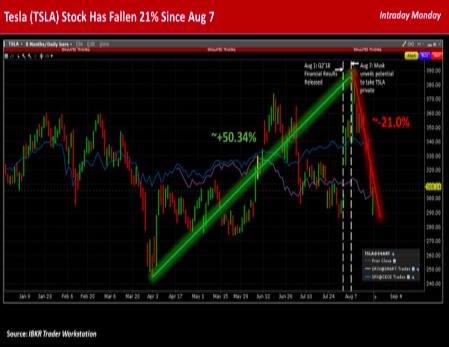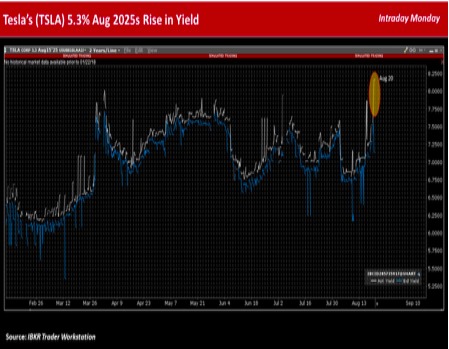By Steven Levine
Senior Market Analyst
Interactive Brokers
While Tesla (TSLA) CEO Elon Musk said on August 7 he was considering taking his electric car producer private, shareholders celebrated while certain bondholders continued to discount the company’s debt.
Musk noted on Tesla’s blog he was mulling privatizing the company at a price of US$420 per share, effectively valuing the firm at around US$66bn.
To date, TSLA’s stock has given back almost twice the precipitous gains it acquired after Musk unleashed his intentions on the blog and on Twitter, as well as after its Q2’18 earnings results.
The company’s market cap was last quoted at about US$52bn, with its shares slipping below the US$300 mark at roughly US$299.10 intraday Monday.

While Tesla’s CEO said “a final decision has not yet been made” about the privatization, he attributed part of his reason to avoiding the “wild swings” in its stock price, as well as being subjected to the quarterly earnings cycle.
Musk noted that “as the most shorted stock in the history of the stock market, being public means that there are large numbers of people who have the incentive to attack the company.”
Short Position
Sam Pierson, director of securities finance at IHS Markit, noted that while “the claim of ‘most shorted stock in the history of the stock market’ is not literally true in dollar terms,” it is “fair in the sense that there has not been another U.S. equity short position greater than $10bn which lasted for more than a quarter.”
Pierson said that with US$3.8bn in convertible debt outstanding, it is “possible that a significant percentage of that value could be short the equity as a hedge.” He continued that contingent on how many of the convertible notes are hedged with equity short positions, TSLA may be closer in its short position to the second highest U.S. equity, Amazon (AMZN), which has US$8.8bn in short balances.
Pierson added it is important to note, however, that “the AMZN short is likely a hedge for many short sellers, rather than an outright bet against the firm’s prospects.”
IHS Markit observed TSLA reached a peak short value of just over US$13bn on August 7, the same day as its blog post, and since then the firm’s falling stock price and a 2m share reduction in shorts have taken the position down to just under US$11.5bn on roughly 33m shares.
Meanwhile, perceptions about the firm’s creditworthiness has suffered significantly, after reports the SEC recently issued TSLA a subpoena regarding Musk’s aim to take his public company private, as well as after questions surfaced about the CEO’s health following a recent interview published in The New York Times.
Five-year CDS spreads Monday suggested the news has stoked the firm’s default probability, with an increase of over 11.5bps to nearly 590bps.
Also, its 5.3% senior unsecured notes due August 2025 were trading more than 30bps wider on the day Monday at an OAS of 476bps, or just north of US$87.50.

As much as shareholders seem to have placed their faith in TSLA’s management and potential future profitability, Interactive Brokers chief options strategist Steve Sosnick recently warned that if an investor is “a true believer in the company, before anything else happens they have to be able to pay back their creditors.”
Sosnick added that from a risk perspective, “if the bondholders don’t get paid, your stock is worthless or essentially worthless.”
Credit Concerns
Among other actions, Moody’s Investors Service in late March cut TSLA’s corporate family rating (CFR) one notch to ‘B3’ and its unsecured credit rating to ‘Caa1’ from ‘B3’, partly due to liquidity pressures stemming from “large” negative free cash flow, as well as the pending maturities of its convertible bonds (US$230m in November 2018 and US$920m in March 2019).
Moody’s noted its negative outlook on TSLA reflected the likelihood that the firm “will have to undertake a large, near-term capital raise in order to refund maturing obligations and avoid a liquidity short-fall.”
Compounding the concerns, TSLA’s US$1.8bn of 5.3% 2025 notes comes with a change of control contingency in its terms and conditions, meaning the company would need to tender the debt at 101 cents on the dollar should any investor(s) purchase a majority stake in the company, and the bonds become downgraded by credit rating agencies.
Credit analysts have been generally questioning whether the change of control contingency will be triggered in the event TSLA goes private.
Further challenges
In the meantime, a long list of headwinds further complicates TSLA’s debt picture, including funding needs for its new Gigafactory 3 in China, as well as adverse impacts from trade-related tariffs.
TSLA has roughly US$9bn worth of net debt and plans to heap on additional debt to help finance its estimated US$2bn, wholly-owned Gigafactory 3 facility in Shanghai.
TSLA said it expects construction on the factory to start within the next few quarters, while its initial investment “will not start in any significant way until 2019, with much of it expected to be funded through local debt.”
While construction on the factory is not slated to start for at least another year, it appears TSLA has already begun to lure potential recruits based on several senior-level position listings for the Shanghai-based facility on its website.
Meanwhile, the electric-carmaker said that although tariffs on vehicle imports to China recently fell to 15%, imports specifically from the U.S. have increased to 40%, compelling TSLA to adjust pricing in China to partially offset the increased cost. The firm warned it will likely suffer some negative impact on its volumes in China in the near-term.
Furthermore, TSLA said higher import duties on Chinese components and unfavorable currency movements are likely to cause negative pressures.
Despite many analysts’ concerns about TSLA’s liquidity, its funding needs for debt and ongoing operations, as well as expansion costs and higher import duties, TSLA said in its Q2’18 earnings report that it continues to expect to achieve GAAP profitability in Q3 and Q4.
Overall, while TSLA’s potential take-private transaction may be one option to alleviate its massive short position, it may do little to assuage bondholders given its operational and debt-service funding needs.
(This post was originally published on August 21, 2018.)
Photo Credit: cdorobeck via Flickr Creative Commons
The analysis in this material is provided for information only and is not and should not be construed as an offer to sell or the solicitation of an offer to buy any security. To the extent that this material discusses general market activity, industry or sector trends or other broad-based economic or political conditions, it should not be construed as research or investment advice. To the extent that it includes references to specific securities, commodities, currencies, or other instruments, those references do not constitute a recommendation by IBKR to buy, sell or hold such investments. This material does not and is not intended to take into account the particular financial conditions, investment objectives or requirements of individual customers. Before acting on this material, you should consider whether it is suitable for your particular circumstances and, as necessary, seek professional advice.



